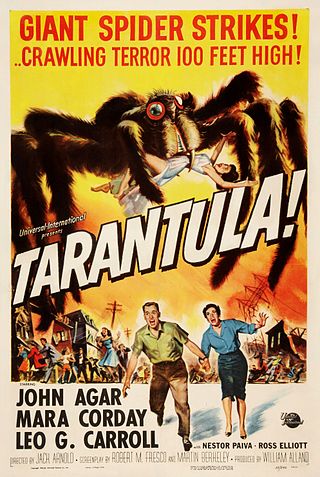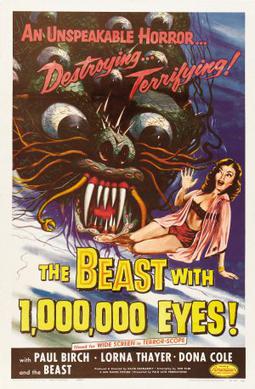
It Came from Beneath the Sea is a 1955 American science fiction monster horror film from Columbia Pictures, produced by Sam Katzman and Charles Schneer, directed by Robert Gordon, that stars Kenneth Tobey, Faith Domergue, and Donald Curtis. The screenplay by George Worthing Yates was designed to showcase the stop motion animation special effects of Ray Harryhausen.

Attack of the Giant Leeches is an independently made, 1959 black-and-white science fiction-horror film, produced by Gene Corman and directed by Bernard L. Kowalski. It stars Ken Clark, Yvette Vickers, Bruno VeSota and Jan Shepard. The screenplay was written by Leo Gordon. The film was released by American International Pictures on a double bill with A Bucket of Blood. Later, in some areas in 1960, Leeches played on a double bill with the Roger Corman film House of Usher.

Sam Katzman was an American film producer and director. Katzman's specialty was producing low-budget genre films, including serials, which had disproportionately high returns for the studios and his financial backers.

Mara Corday is an American retired showgirl, model, actress, Playboy Playmate, and 1950s cult figure.

Equinox is a 1970 American supernatural horror film directed by Jack Woods, and starring Edward Connell, Barbara Hewitt, Frank Bonner and Robin Christopher. Though uncredited, producer Dennis Muren also served as a second director. The film focuses on four young people picnicking in a California canyon, where they stumble upon an ancient book used to conjure demons; soon they unleash a plethora of evil creatures.

Leslie Irving Morrow, known as Jeff Morrow, was an American actor educated at Pratt Institute in his native New York City. Morrow was a commercial artist prior to turning to acting. Early in his career, he acted on the Broadway stage using the name Irving Morrow.

Tarantula is a 1955 American science-fiction monster film produced by William Alland and directed by Jack Arnold. It stars John Agar, Mara Corday, and Leo G. Carroll. The film is about a scientist developing a miracle nutrient to feed a rapidly growing human population. In its unperfected state, the nutrient causes extraordinarily rapid growth, creating a deadly problem when a tarantula test subject escapes and continues to grow larger and larger. The screenplay by Robert M. Fresco and Martin Berkeley was based on a story by Arnold, which was in turn inspired by Fresco's teleplay for the 1955 Science Fiction Theatre episode "No Food for Thought", also directed by Arnold. The film was distributed by Universal Pictures as a Universal-International release, and reissued in 1962 through Sherman S. Krellberg's Ultra Pictures.
Frederick Francis Sears was an American film actor and director.

Matinee is a 1993 American comedy film directed by Joe Dante. It is about a William Castle-type independent filmmaker, with the American home front during the Cuban Missile Crisis as a backdrop. The film stars John Goodman, Cathy Moriarty, Simon Fenton, Omri Katz, Lisa Jakub, Robert Picardo, Kellie Martin, and Jesse White. It was written by Jerico Stone and Charles S. Haas, the latter portraying Mr. Elroy, a schoolteacher. Despite critical acclaim, the film was a box office failure.

A monster movie, monster film, creature feature or giant monster film is a film that focuses on one or more characters struggling to survive attacks by one or more antagonistic monsters, often abnormally large ones. The film may also fall under the horror, comedy, fantasy, or science fiction genres. Monster movies originated with adaptations of horror folklore and literature.

The Killer Shrews is a 1959 American independent science fiction film directed by Ray Kellogg, and produced by Ken Curtis and Gordon McLendon. The story follows a group of researchers who are trapped in their remote island compound overnight by a hurricane and find themselves under siege by their abnormally large and venomous mutant test subjects. The film stars James Best, Ingrid Goude, Ken Curtis, McLendon, Baruch Lumet and "Judge" Henry Dupree.

The Werewolf is a 1956 American horror science fiction film directed by Fred F. Sears and starring Don Megowan and Joyce Holden.
The Monster of Piedras Blancas is a 1959 American monster film. It was produced by Jack Kevan, directed by Irvin Berwick, and stars Jeanne Carmen, Les Tremayne, John Harmon, Don Sullivan, Forrest Lewis, and Pete Dunn. The film was released by Filmservice Distributors Corporation as a double feature with Okefenokee.

The Cyclops is a 1957 American science fiction horror film written, produced and directed by Bert I. Gordon, starring James Craig, Lon Chaney Jr. and Gloria Talbott.

The Night the World Exploded is a 1957 science fiction, disaster film. The film was written by Jack Natteford and Luci Ward, and directed by Fred F. Sears for producer Sam Katzman. Both Katzman and Sears were great exponents of the low-budget B film genre. The film was theatrically released on a double bill with The Giant Claw.

The Beast with a Million Eyes is a 1955 independently made American black-and-white science fiction film, produced and directed by David Kramarsky, that stars Paul Birch, Lorna Thayer, and Dona Cole. Some film sources have said that the film was co-directed by Lou Place. The film was co-produced by Roger Corman and Samuel Z. Arkoff. and was released by American Releasing Corporation, which later became American International Pictures.

Creature with the Atom Brain is a 1955 American zombie horror science fiction film directed by Edward L. Cahn and starring Richard Denning.

Zombies of Mora Tau is a 1957 black-and-white zombie horror film directed by Edward L. Cahn and starring Gregg Palmer, Allison Hayes and Autumn Russel. Distributed by Columbia Pictures, it was produced by Sam Katzman. The screenplay was written by George H. Plympton and Bernard Gordon. Zombies of Mora Tau was released on a double bill with another Katzman-produced film, The Man Who Turned to Stone (1957).

The Water Horse: Legend of the Deep is a 2007 fantasy drama film directed by Jay Russell and written by Robert Nelson Jacobs, based on Dick King-Smith's children's novel The Water Horse. It stars Alex Etel as a young boy who discovers a mysterious egg and cares for what hatches out of it: a "water horse" which later becomes the fabled Loch Ness Monster. The film also stars Emily Watson, Ben Chaplin and David Morrissey.

Paul Blaisdell was an American painter, sculptor and visual effects creator, best remembered for his work in science fiction and horror B movies of the 1950s.





















